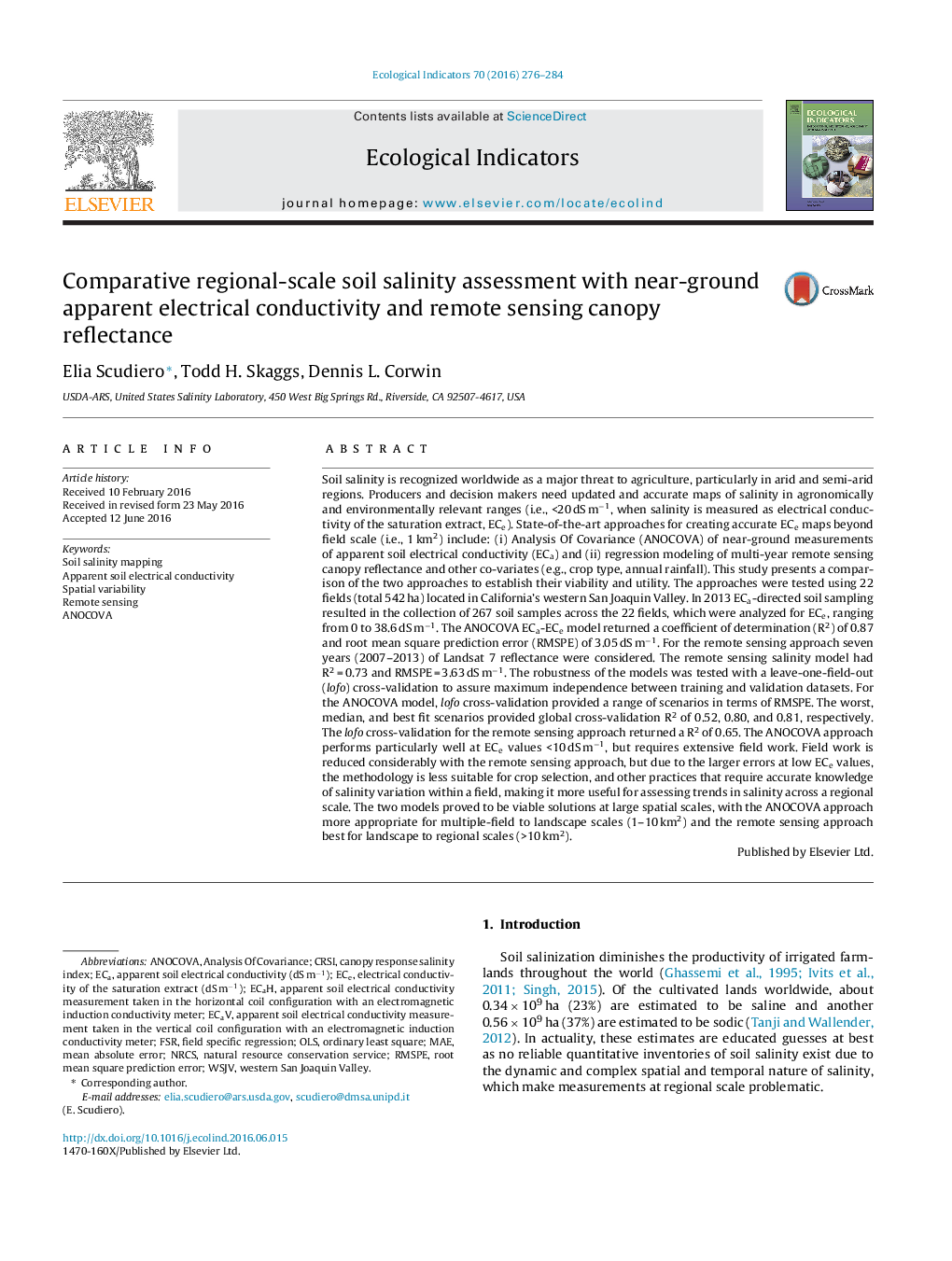| کد مقاله | کد نشریه | سال انتشار | مقاله انگلیسی | نسخه تمام متن |
|---|---|---|---|---|
| 6293094 | 1617132 | 2016 | 9 صفحه PDF | دانلود رایگان |
عنوان انگلیسی مقاله ISI
Comparative regional-scale soil salinity assessment with near-ground apparent electrical conductivity and remote sensing canopy reflectance
ترجمه فارسی عنوان
ارزیابی شوری خاک در مقیاس منطقه ای با هدایت الکتریکی ظاهری زمین و بازتاب سنجی از راه دور سنجش از راه دور
دانلود مقاله + سفارش ترجمه
دانلود مقاله ISI انگلیسی
رایگان برای ایرانیان
کلمات کلیدی
ECAOLSRMSPEFSRNRCSECe - ECAMAE - بلهanalysis of covariance - تجزیه و تحلیل کوواریانسSpatial variability - تنوع فضاییNatural Resource Conservation Service - خدمات حفاظت از منابع طبیعیroot mean square prediction error - خطای پیش بینی میانگین مربع ریشهRemote sensing - سنجش از راه دورordinary least square - عادی حداقل مربعMean Absolute Error - میانگین خطا مطلقApparent soil electrical conductivity - هدایت الکتریکی ظاهری خاک
موضوعات مرتبط
علوم زیستی و بیوفناوری
علوم کشاورزی و بیولوژیک
بوم شناسی، تکامل، رفتار و سامانه شناسی
چکیده انگلیسی
Soil salinity is recognized worldwide as a major threat to agriculture, particularly in arid and semi-arid regions. Producers and decision makers need updated and accurate maps of salinity in agronomically and environmentally relevant ranges (i.e., <20Â dSÂ mâ1, when salinity is measured as electrical conductivity of the saturation extract, ECe). State-of-the-art approaches for creating accurate ECe maps beyond field scale (i.e., 1Â km2) include: (i) Analysis Of Covariance (ANOCOVA) of near-ground measurements of apparent soil electrical conductivity (ECa) and (ii) regression modeling of multi-year remote sensing canopy reflectance and other co-variates (e.g., crop type, annual rainfall). This study presents a comparison of the two approaches to establish their viability and utility. The approaches were tested using 22 fields (total 542Â ha) located in California's western San Joaquin Valley. In 2013 ECa-directed soil sampling resulted in the collection of 267 soil samples across the 22 fields, which were analyzed for ECe, ranging from 0 to 38.6Â dSÂ mâ1. The ANOCOVA ECa-ECe model returned a coefficient of determination (R2) of 0.87 and root mean square prediction error (RMSPE) of 3.05Â dSÂ mâ1. For the remote sensing approach seven years (2007-2013) of Landsat 7 reflectance were considered. The remote sensing salinity model had R2Â =Â 0.73 and RMSPEÂ =Â 3.63Â dSÂ mâ1. The robustness of the models was tested with a leave-one-field-out (lofo) cross-validation to assure maximum independence between training and validation datasets. For the ANOCOVA model, lofo cross-validation provided a range of scenarios in terms of RMSPE. The worst, median, and best fit scenarios provided global cross-validation R2 of 0.52, 0.80, and 0.81, respectively. The lofo cross-validation for the remote sensing approach returned a R2 of 0.65. The ANOCOVA approach performs particularly well at ECe values <10Â dSÂ mâ1, but requires extensive field work. Field work is reduced considerably with the remote sensing approach, but due to the larger errors at low ECe values, the methodology is less suitable for crop selection, and other practices that require accurate knowledge of salinity variation within a field, making it more useful for assessing trends in salinity across a regional scale. The two models proved to be viable solutions at large spatial scales, with the ANOCOVA approach more appropriate for multiple-field to landscape scales (1-10Â km2) and the remote sensing approach best for landscape to regional scales (>10Â km2).
ناشر
Database: Elsevier - ScienceDirect (ساینس دایرکت)
Journal: Ecological Indicators - Volume 70, November 2016, Pages 276-284
Journal: Ecological Indicators - Volume 70, November 2016, Pages 276-284
نویسندگان
Elia Scudiero, Todd H. Skaggs, Dennis L. Corwin,
